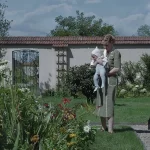Chasing Grace, by Josh Long

Terrence Malick has always been a filmmaker who points to the beauty, majesty, and wonder in all the things his lens captures. In many of his past films, the setting has been outside the purview of modern-day Americans, so it may have been easier to engage with the films on that level. The Thin Red Line transported us to the South Pacific during World War II; The New World showed us pre-colonial America. With subjects so outside of our daily experience, it’s easier to find that sense of wonder. And yet, with The Tree of Life and now with To the Wonder, Malick has moved much closer to home, and is still able to show us the beauty in the familiar – a tire swing, a kitchen table, an oil derrick, the supermarket.
The Tree of Life explored the conflict between “nature and grace” and the presence of evil (sin, if you prefer) in our world, and more troubling, in ourselves. In the same way, To the Wonder explores the experience of love, both romantic and spiritual. Neil and Marina (Ben Affleck and Olga Kurylenko) are lovers who meet in France, and eventually move to Oklahoma, bringing along Marina’s daughter Tatiana. Other key characters that arise are Jane (Rachel McAdams), a love interest from Neil’s past, and Father Quintana (Javier Bardem) a priest who, like Marina, is an expatriate living in Oklahoma.
As fans will expect from Malick, the plot (such as it is) is secondary to the tone. It plays more like a visual flow of emotions and ideas than a construction of scenes. There is constant movement, both in camera work and editing. The film moves like the human mind might; it flows in and out, backwards and forward, much like memory. The voiceover, characteristic of Malick, once again gives us a straightforward, nothing-held-back look into the minds of the characters. This approach as a whole makes the film feel almost musical, a symphony of sights and sounds that, when combined, illicit a compounded aesthetic reaction.
In this whirling, lyrical way, the film hones in on what it is to love and to be in love (which, it should be noted, are two different things). We feel all the aspects of being in love from Marina. At some points she is in blissful dependence of Neil – she speaks of him as of a savior. Other times she feels complete abandonment, loss, hopelessness. The fact that it isn’t bound to a strict timeline allows the story to freely explore this massive range of emotion. Love isn’t just a happy feeling. Marina and Neil are tortured by it as often as they are elevated. Perhaps their pain derives in part from idealizing their love. Early in the film we see them visiting Mont Saint-Michel, and the beauty they experience there, combined with the deep connection they feel at that moment, may become a height they wish for, but can never reach again. This isn’t to say that there can be no more beautiful moments in their love story – indeed, there are – but if an ideal always lingers as the standard, they may always feel incomplete.
This leads into a discussion of Father Quintana, Neil and Marina’s parish priest in Oklahoma. Quintana’s story is heartbreaking. He has committed himself to God, and holds a firm belief in Him, but doesn’t feel God’s presence, as once he did. He believes that God loves him, but must endure the pain of going day by day without seeing it or feeling it. Perhaps, like Marina, he longs for a time when love was evident and simpler; undeniable.
Still, Quintana’s belief in God’s love drives him to display it to others. He spends a great deal of his time with the marginalized. He talks to people in the slums, visits convalescents in the hospital, the mentally challenged, and the homeless. We never get the sense that he’s condemning them or asking them to repent. He’s simply loving them, as he believes Christ would have. From the pulpit, he speaks of love as not just a feeling, but also a duty. With some of those he meets, it does become a duty, as some openly reject or scorn him. Perhaps this is meant to make us wonder if even God would feel the sting of love given, but not returned.
I have always been an admirer of Terrence Malick’s work, but must say that this time around I was particularly struck by the mastery in the editing. I don’t know how much of a hand Malick personally has in this department, but to take such a massive amount of footage and cut it in a non-linear fashion with such a focused aesthetic result is quite fantastic. A team of five is credited with the film editing, so it’s undoubtedly a monster of a job. With so many little moments, so many isolated shots, and a film that can at any moment jump forward to any other moment, achieving a cohesive emotional message is a fantastic accomplishment.
Another great offering by one of American cinema’s living masters, To the Wonder is a film experience you won’t soon forget.





























Looking forward to this film. The part about Father Q. sounds like Bergman’s The Silence.
Good write-up, Josh. Thanks for reading, West! I think it’s been a while and I missed these read reviews.
* I meant Winter Light not The Silence, same year and director. God’s silence is what the pastor feels in that movie, that’s why I mixed it up.